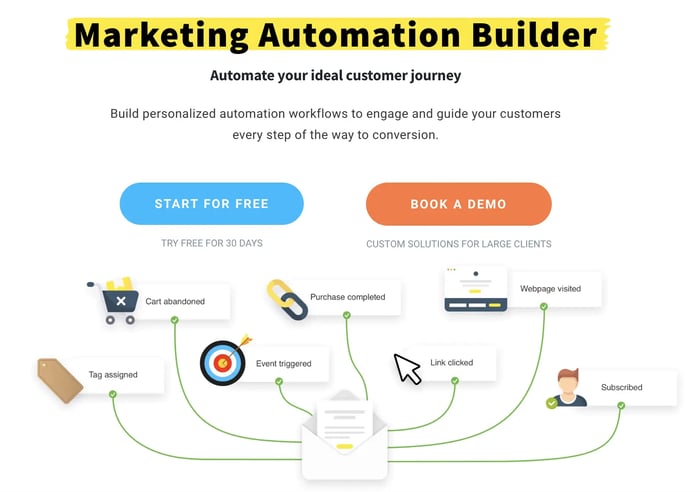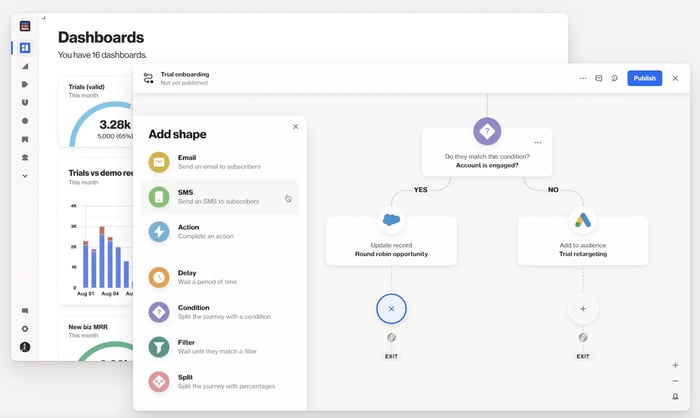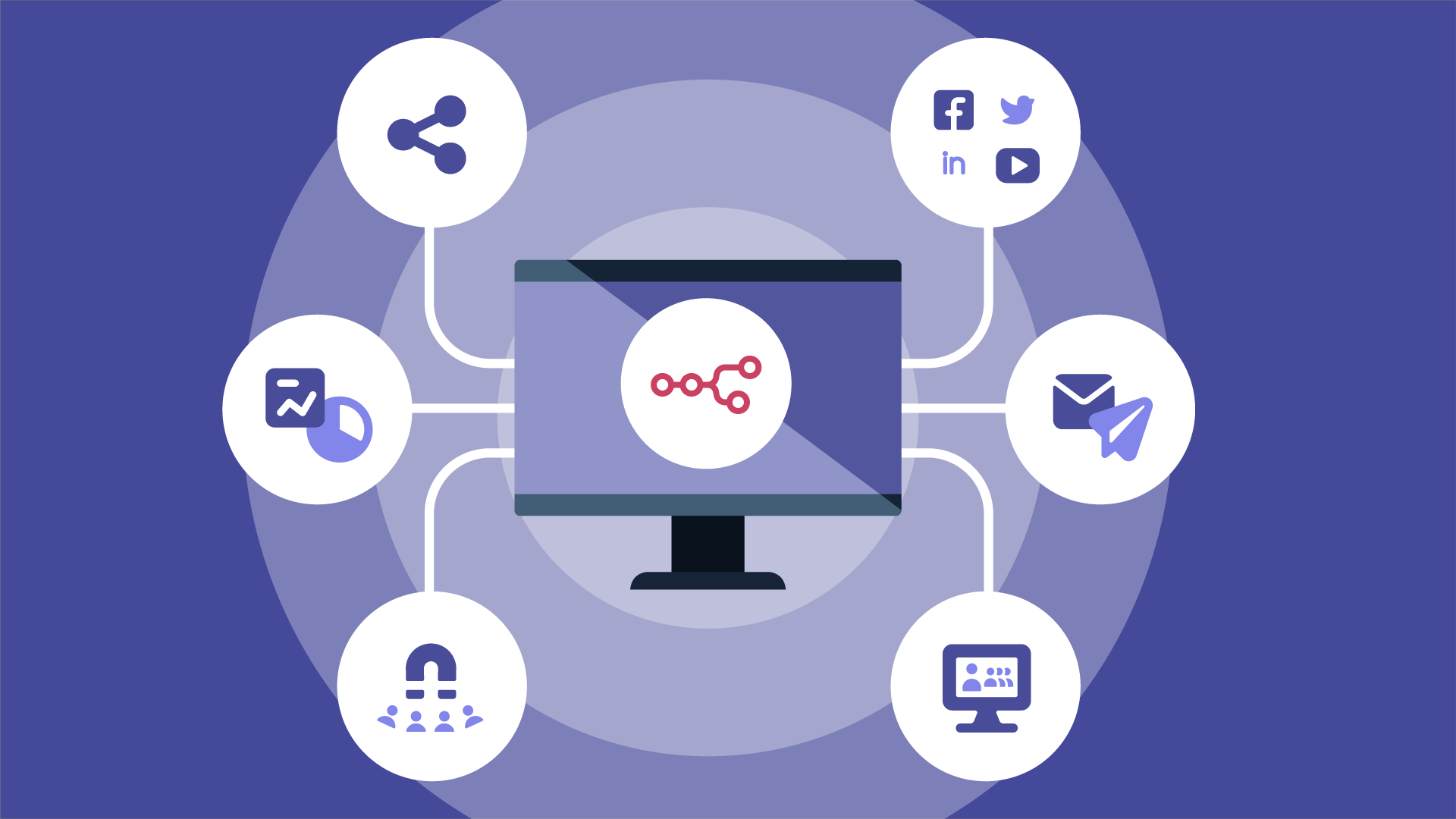Tools for marketing automation streamline tasks like email campaigns, social media posting, and lead management. They save time and improve efficiency.
Marketing automation tools revolutionize how businesses handle repetitive tasks. These tools automate email campaigns, social media posts, and customer segmentation. Marketers can focus on strategy rather than manual tasks. Popular tools include HubSpot, Mailchimp, and Hootsuite. They offer analytics to measure campaign success and optimize future efforts.
Automation enhances customer engagement and drives conversions. Small businesses to large enterprises can benefit. Investing in marketing automation tools boosts productivity and ROI.
Introduction To Marketing Automation
Marketing automation tools help businesses save time and effort. These tools streamline repetitive tasks. They also allow companies to focus on strategy and creativity.
Automation tools have revolutionized the marketing landscape. They provide consistent results and help in scaling marketing efforts. Let’s explore the evolution and benefits of marketing automation.
The Evolution Of Digital Marketing
Digital marketing has changed rapidly over the years. Initially, businesses relied on simple emails and basic websites. Today, we have advanced tools and platforms.
In the early days, marketers manually handled most tasks. This approach was time-consuming and prone to errors. The rise of social media and search engines brought new challenges and opportunities.
Automation emerged as a game-changer. It allowed for more precise targeting and tracking. Marketers could now reach their audience with personalized messages. Tools like CRM systems, email marketing platforms, and social media schedulers became essential.
Benefits Of Automating Marketing Tasks
Automating marketing tasks offers several advantages. Here are some key benefits:
- Time-saving: Automation handles repetitive tasks, freeing up time.
- Consistency: Automated campaigns ensure consistent messaging.
- Efficiency: Automation reduces errors and improves accuracy.
- Scalability: Easily manage large-scale campaigns with automation.
- Data-driven insights: Gain valuable insights through analytics and reports.
These benefits help businesses achieve better results. Automation tools enhance productivity and improve marketing ROI.
Key Features Of Automation Tools
Marketing automation tools are essential for streamlining and enhancing your marketing efforts. They offer a range of features designed to save time and improve efficiency. Here, we will discuss the key features of automation tools that can transform your marketing strategy.
Segmentation And Personalization
Segmentation allows you to divide your audience into specific groups. These groups can be based on behavior, demographics, or interests. Personalization involves tailoring content to match the preferences of each segment. This feature ensures that your messages are relevant and engaging.
- Dynamic Content: Customize emails and landing pages for each segment.
- Targeted Campaigns: Send specific offers to different audience groups.
- Behavioral Triggers: Automate responses based on user actions.
Workflow And Campaign Management
Workflow and campaign management features help automate complex processes. These tools simplify the creation, execution, and tracking of marketing campaigns. They ensure that each step of your campaign runs smoothly.
| Feature | Description |
|---|---|
| Drag-and-Drop Editors | Create workflows easily with intuitive interfaces. |
| Pre-built Templates | Use ready-made templates to save time. |
| Analytics and Reporting | Track campaign performance with detailed reports. |
These key features make marketing automation tools invaluable. They help you reach the right people with the right message at the right time.
Popular Marketing Automation Platforms
Marketing automation platforms streamline marketing tasks, making campaigns more efficient. These tools help businesses save time and improve results. Let’s dive into some of the most popular marketing automation platforms available today.
Exploring Industry Leaders
Several marketing automation platforms stand out for their features and reliability. Here are some industry leaders:
- HubSpot: Known for its user-friendly interface and comprehensive tools.
- Marketo: Offers advanced analytics and robust integration capabilities.
- ActiveCampaign: Combines email marketing with automation and CRM features.
- Pardot: Tailored for B2B marketing, offering powerful lead nurturing tools.
- Mailchimp: Popular for its simplicity and wide range of email templates.
Comparing Pricing And Features
Understanding the pricing and features is crucial for choosing the right platform. Below is a comparison of some key players:
| Platform | Starting Price (per month) | Key Features |
|---|---|---|
| HubSpot | $50 |
|
| Marketo | $1,195 |
|
| ActiveCampaign | $9 |
|
| Pardot | $1,250 |
|
| Mailchimp | $10 |
|
These platforms offer diverse features to meet various marketing needs. Choose based on your budget and required features.
Email Marketing Automation
Email marketing automation is a powerful tool for modern marketers. It helps save time, increase efficiency, and improve campaign results. By automating repetitive tasks, marketers can focus on strategy and creativity. Below, we explore key aspects of email marketing automation.
Crafting Targeted Email Campaigns
Creating targeted email campaigns is vital for engagement. Segment your audience based on demographics, behavior, and preferences. Use personalization to make emails relevant. Here’s a quick guide:
- Segment Audience: Group subscribers by age, location, and interests.
- Use Dynamic Content: Tailor messages with names and preferences.
- A/B Testing: Test subject lines and email content for better results.
Personalized emails have higher open rates. They also drive more conversions.
Analyzing Email Performance Metrics
Measuring email performance is crucial. Key metrics to track include:
| Metric | Description |
|---|---|
| Open Rate | Percentage of emails opened by recipients. |
| Click-Through Rate (CTR) | Percentage of recipients who clicked a link in the email. |
| Bounce Rate | Percentage of emails not delivered. |
| Conversion Rate | Percentage of recipients who completed a desired action. |
Use these metrics to refine your email campaigns. Track performance regularly. Make data-driven decisions for continuous improvement.
Social Media Scheduling And Analytics
Social Media Scheduling and Analytics are crucial for modern businesses. They help streamline content distribution and measure engagement. These tools save time and provide valuable insights.
Efficient Content Distribution
Social media scheduling tools like Hootsuite and Buffer allow you to plan and automate posts. You can schedule content for days, weeks, or months in advance. This ensures a consistent online presence.
With these tools, you can also tailor content for different platforms. This helps in reaching diverse audiences effectively. You can even set specific times for posts to go live. This maximizes visibility and engagement.
| Tool | Key Feature |
|---|---|
| Hootsuite | Bulk scheduling |
| Buffer | Post optimization |
Measuring Engagement And Reach
Knowing how your audience interacts with your content is vital. Analytics tools provide insights into user behavior. Platforms like Sprout Social and Google Analytics offer detailed reports. These reports include metrics like likes, shares, and comments.
You can also track the reach of your posts. This helps in understanding the effectiveness of your strategy. By analyzing this data, you can refine your content for better results.
- Sprout Social: Comprehensive social media analytics
- Google Analytics: In-depth website traffic insights
Regularly reviewing these metrics helps in making informed decisions. This ensures continuous improvement in your social media strategy.
Lead Nurturing And Scoring
Lead nurturing and scoring are essential parts of marketing automation. They help businesses build relationships and prioritize sales-ready leads. By using these tools, companies can enhance their marketing efforts and drive better results.
Building Relationships With Prospects
Marketing automation tools help in building relationships with prospects. These tools send personalized emails to potential customers. They also track their interactions with your content. This data helps you understand their interests and needs.
Using this information, you can create targeted campaigns. These campaigns are more likely to engage prospects. As a result, you can convert them into loyal customers. Consistent communication keeps your brand top-of-mind for prospects.
Here are some key features for building relationships:
- Automated email sequences
- Personalized content recommendations
- Behavior tracking
- Lead segmentation
Prioritizing Sales-ready Leads
Lead scoring helps in prioritizing sales-ready leads. This process assigns a score to each lead based on their behavior. For example, visiting your pricing page might have a higher score than reading a blog post.
The higher the score, the more likely the lead is ready to buy. Sales teams can focus on these high-scoring leads first. This increases the chances of closing deals quickly.
Key factors in lead scoring include:
- Website visits
- Email opens and clicks
- Content downloads
- Form submissions
By prioritizing these leads, your sales team can work more efficiently. They spend less time on cold leads and more time on those ready to convert.
| Feature | Benefit |
|---|---|
| Automated Email Sequences | Maintains regular contact with prospects |
| Personalized Content Recommendations | Increases engagement rates |
| Lead Segmentation | Targets the right audience |
| Behavior Tracking | Provides insights into prospect interests |
| Lead Scoring | Prioritizes high-potential leads |
Integrating Crm With Automation Tools
Integrating CRM with marketing automation tools can transform your business. It helps streamline operations and improve customer interactions. This synergy ensures that data flows seamlessly across systems. The result is a unified approach to customer management and marketing.
Centralizing Customer Data
One major benefit of integrating CRM with automation tools is centralizing customer data. All customer interactions are stored in one place. This makes it easy to access and analyze data.
Consider the following advantages:
- Unified view of customer history
- Accurate tracking of customer interactions
- Improved data accuracy by reducing manual entry
Centralized data allows for better decision-making. Teams can craft personalized marketing campaigns. This leads to higher engagement and conversions.
Enhancing Sales And Marketing Alignment
Integrating CRM with automation tools also enhances sales and marketing alignment. These teams can share insights and work collaboratively. This alignment ensures consistent messaging and strategies.
Key benefits include:
- Improved communication between teams
- Streamlined workflows for lead management
- Enhanced reporting and analytics
When sales and marketing work together, the customer experience improves. The sales team can follow up on leads generated by marketing. This results in higher conversion rates and customer satisfaction.
Table: Benefits Of Integrating Crm With Automation Tools
| Benefit | Description |
|---|---|
| Centralized Data | All customer information in one place |
| Enhanced Alignment | Better collaboration between sales and marketing |
| Improved Efficiency | Streamlined processes and workflows |
| Higher Conversions | Increased conversion rates and sales |

Credit: blog.hubspot.com
Measuring The Success Of Automation
Understanding the impact of marketing automation is crucial for any business. You need to know if your tools are effective. This section will explore ways to measure success. We’ll focus on key performance indicators and the ROI of marketing automation.
Key Performance Indicators
Key Performance Indicators (KPIs) are essential for tracking success. Here are some important KPIs for marketing automation:
- Conversion Rate: Measures the percentage of visitors who take action.
- Click-Through Rate (CTR): Shows how many people click on your links.
- Open Rate: Indicates how many people open your emails.
- Customer Retention Rate: Tracks how many customers keep coming back.
- Lead Generation: Counts the number of new leads acquired.
These KPIs help you understand user behavior. They show which strategies work best.
Roi Of Marketing Automation
Calculating the Return on Investment (ROI) helps measure the financial success. Here’s a simple formula to calculate ROI:
ROI = (Revenue Generated - Cost of Automation) / Cost of AutomationLet’s break this down:
| Metric | Description |
|---|---|
| Revenue Generated | Total income from marketing efforts |
| Cost of Automation | Expenses related to automation tools |
For example, if your revenue is $10,000 and the cost is $2,000:
ROI = ($10,000 - $2,000) / $2,000 = 4 or 400%This means you earned four times what you spent. High ROI indicates successful automation. Always aim for a positive ROI. This shows your automation strategy works well.
Future Trends In Marketing Automation
The world of marketing automation is evolving rapidly. New trends shape the future. Understanding these trends is crucial for staying ahead. Let’s explore the future of marketing automation.
Ai And Machine Learning
Artificial Intelligence (AI) and Machine Learning (ML) are revolutionizing marketing. They help businesses make smarter decisions. AI and ML can analyze large data sets quickly. This leads to more personalized marketing strategies.
With AI, companies can automate tasks that were once manual. Examples include email marketing, social media posting, and customer segmentation. This saves time and increases efficiency.
Machine Learning helps in predicting customer behavior. It can suggest the best product or service for each customer. This improves customer satisfaction and increases sales.
Predictive Analytics In Marketing
Predictive Analytics is another key trend. It uses data to predict future outcomes. This helps businesses plan their marketing strategies better.
Predictive Analytics can forecast customer needs. This ensures that marketing efforts are more targeted and effective. It also helps in identifying trends and patterns in customer behavior.
Below is a table summarizing the benefits of Predictive Analytics:
| Benefit | Description |
|---|---|
| Enhanced Targeting | Reach the right audience with personalized messages. |
| Improved ROI | Efficient use of marketing budget for better returns. |
| Customer Retention | Identify and address customer needs promptly. |
Using Predictive Analytics, businesses can stay competitive. It allows for more informed decision-making. This leads to better marketing outcomes.

Credit: blog.hubspot.com
Best Practices For Implementing Automation Tools
Implementing marketing automation tools can significantly boost your marketing efforts. To maximize their benefits, follow these best practices. Proper planning and continuous monitoring are crucial.
Setting Clear Objectives
Before implementing any tool, set clear objectives. Know what you aim to achieve.
- Increase lead generation
- Improve customer engagement
- Boost conversion rates
Define your key performance indicators (KPIs). These metrics will help measure success. Ensure everyone on your team understands these goals.
Continuous Monitoring And Optimization
Marketing automation is not a set-and-forget task. Continuous monitoring is essential. Track your campaigns regularly.
Use analytics tools to measure performance. Identify what works and what doesn’t. Make data-driven decisions to optimize your strategies.
| Metric | Tool |
|---|---|
| Website Traffic | Google Analytics |
| Email Open Rates | Mailchimp |
| Social Media Engagement | Hootsuite |
Regularly update your content and strategies. Stay flexible to adapt to new trends.
By setting clear objectives and monitoring your efforts, you can effectively use marketing automation tools. This will lead to better results and improved efficiency.
Challenges And Considerations
Marketing automation tools are crucial for scaling and optimizing campaigns. However, they come with their own set of challenges and considerations. Understanding these can help you avoid common pitfalls and maintain authentic customer experiences.
Avoiding Common Pitfalls
Marketing automation can be a double-edged sword. While it offers efficiency, it can also lead to common pitfalls:
- Over-Automation: Automating too many tasks can make your marketing feel robotic.
- Data Mismanagement: Poor data handling can result in inaccurate targeting.
- Ignoring Analytics: Not analyzing results can waste your efforts.
To avoid these issues, consider the following strategies:
- Set Clear Goals: Define what you want to achieve with automation.
- Regular Audits: Frequently review your automation processes for efficiency.
- Balance Automation: Use automation to assist, not replace, human interaction.
Maintaining Authentic Customer Experiences
Maintaining an authentic customer experience is crucial. Automation should not feel impersonal:
- Personalization: Customize messages to address individual customer needs.
- Timely Interactions: Ensure automated messages are sent at appropriate times.
- Human Touch: Include human elements where necessary to keep it real.
Consider these tips to maintain authenticity:
| Tip | Description |
|---|---|
| Dynamic Content | Use dynamic content to personalize emails and messages. |
| Feedback Loops | Regularly collect and act on customer feedback. |
| Segment Audience | Segment your audience to tailor messages effectively. |
By focusing on these areas, you can leverage marketing automation without losing the human touch.

Credit: blog.n8n.io
Frequently Asked Questions
What Is A Marketing Automation Tool?
A marketing automation tool streamlines marketing tasks. It automates email campaigns, social media posts, and customer segmentation. This software helps businesses save time, improve efficiency, and personalize marketing efforts.
What Are The Best Marketing Automation Tools?
The best marketing automation tools include HubSpot, Marketo, ActiveCampaign, Pardot, and Mailchimp. These platforms offer robust features for email marketing, lead management, and analytics.
How To Automate Your Marketing?
Automate your marketing by using tools like HubSpot, Mailchimp, or Hootsuite. Schedule posts, emails, and track analytics. Integrate CRM systems for personalized campaigns. Optimize with A/B testing.
What Are Crm Automation Tools?
CRM automation tools streamline customer relationship management tasks. They automate data entry, follow-ups, and customer interactions. These tools enhance productivity, improve customer service, and boost sales. Popular CRM automation tools include Salesforce, HubSpot, and Zoho CRM.
Conclusion
Marketing automation tools can transform your business. They streamline tasks, improve efficiency, and boost customer engagement. Leveraging these tools leads to smarter marketing strategies. Stay ahead by adopting the right automation solutions. Your business growth and productivity will thank you.
Explore your options, and watch your marketing efforts soar.



